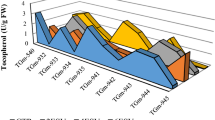Abstract
In order to investigate the genetic differences in uptake and distribution of cadmium in soybeans, 17 varieties of soybean were grown first in soil and then four or five varieties of soybean were grown in nutrient solution with different levels of cadmium.Significant genotypic differences in seed cadmium levels were found. The seed cadmium concentration was lowest for the En-b0-1-2 soybean variety, and highest for Harosoy, in both field and pot experiments. The seed cadmium levels of Tohoku 128, a cross between Enrei and Suzuyutaka, were intermediate between those of the parents. For four soil types, containing from 0.2 to 6.5 mg kg−1 extractable cadmium, the ranking of soybean genotypes based on seed cadmium level was similar, indicating that there is a genetic factor involved in the varietal differences in cadmium concentration. Among the four soybean varieties tested in one experiment in the present study, the cadmium concentrations in leaves, stems and pods as well as the total cadmium uptake were lowest for En-b0-1-2. These results suggest that cadmium uptake and/or translocation from root to shoot are low in En-b0-1-2. In solution culture containing 100 μg L−1 cadmium, the cadmium concentrations in seeds, stems and pods at the seed maturation stage were also the lowest for En-b0-1-2. In a second experiment, the cadmium concentrations in the leaves, stem and petiole were lower at both 7 and 15 days after the addition of cadmium to the nutrient solution for En-b0-1-2 and Enrei than for Tohoku 128, Suzuyutaka and Harosoy; however, the cadmium concentrations of roots for En-b0-1-2 and Enrei were higher than for the other varieties. We propose that the lower levels of cadmium found in the seeds of certain varieties of soybean result from the combination of lower initial uptake and retention of higher levels of cadmium in the roots, thus limiting its translocation to the shoot.
Similar content being viewed by others
References
Akao S and Kouchi H 1989 Light microscopic observation of root hair curling of soybeans induced by Rhizobium infection. Jpn. J. Soil Sci. Plant Nutr. 60, 53-55.
Boggess S F, Willavize S and Koeppe D E 1978 Differential response of soybean varieties to soil cadmium. Agron. J. 70, 756-760.
Florijn P J and Van Beusichem M L 1993 Uptake and distribution of cadmium in maize inbred lines. Plant Soil 150, 25-32.
Hart J J, Welch R M, Norvell W A, Sullivan L A and Kochian L V 1998 Characterization of cadmium binding, uptake, and translocation in intact seedlings of bred and durum wheat cultivars. Plant Physiol. 116, 1413-1420.
Li Y-M, Chaney R L, Schneiter A A, Miller J F, Elias E M and Hammond J J 1997 Screening for low grain cadmium phenotypes in sunflower, durum wheat and flax. Euphytica 94, 23-30.
Morishita T, Fumoto N, Yoshizawa T and Kagawa K 1987 Varietal differences in cadmium levels of rice grains of japonica, indica, javanica and hybrid varieties produced in the same plot of a field. Soil Sci. Plant Nutr. 33,629-637.
Nishizono H, Kubota K, Suzuki S and Ishii F 1989 Accumulation of heavy metals in cell walls of polygonum cuspidatum roots from metalliferous habitats. Plant Cell Physiol. 30, 595-598.
Reddy M R and Dunn S J 1986 Heavy metal absorption by soybean on sewage sludge treated soil. J. Agric. Food Chem. 34, 750-753.
Report of the 33rd Session of the Codex Committee on Food Additives and Contaminants. Hague, The Netherlands 12-16 March 2001, p. 285.
Subbarao G V and Johansen C 2001 Physiological mechanisms relevant to genetic improvement of salinity tolerance in crop plants. In Handbook of Plant and Crop Physiology. Ed. M Pessarakli. pp. 857-880. Marcel Dekker, New York.
Takahashi M, Arihara J, Nakayama N and Kokubun M 2003 Characteristics of growth and yield formation in the improved genotype of supernodulating soybean (Glycine max L. Merr.). Plant Prod. Sci. 6, (in press).
Tessier A, Campbell P G C and Bisson M 1979 Sequential procedure for the speciation of particulate trace metals. Anal. Chem. 51, 844-851.
Wagner G J 1993 Accumulation of cadmium in crop plants and its consequences to human health. Adv. Agron. 51, 173-212.




